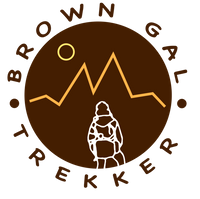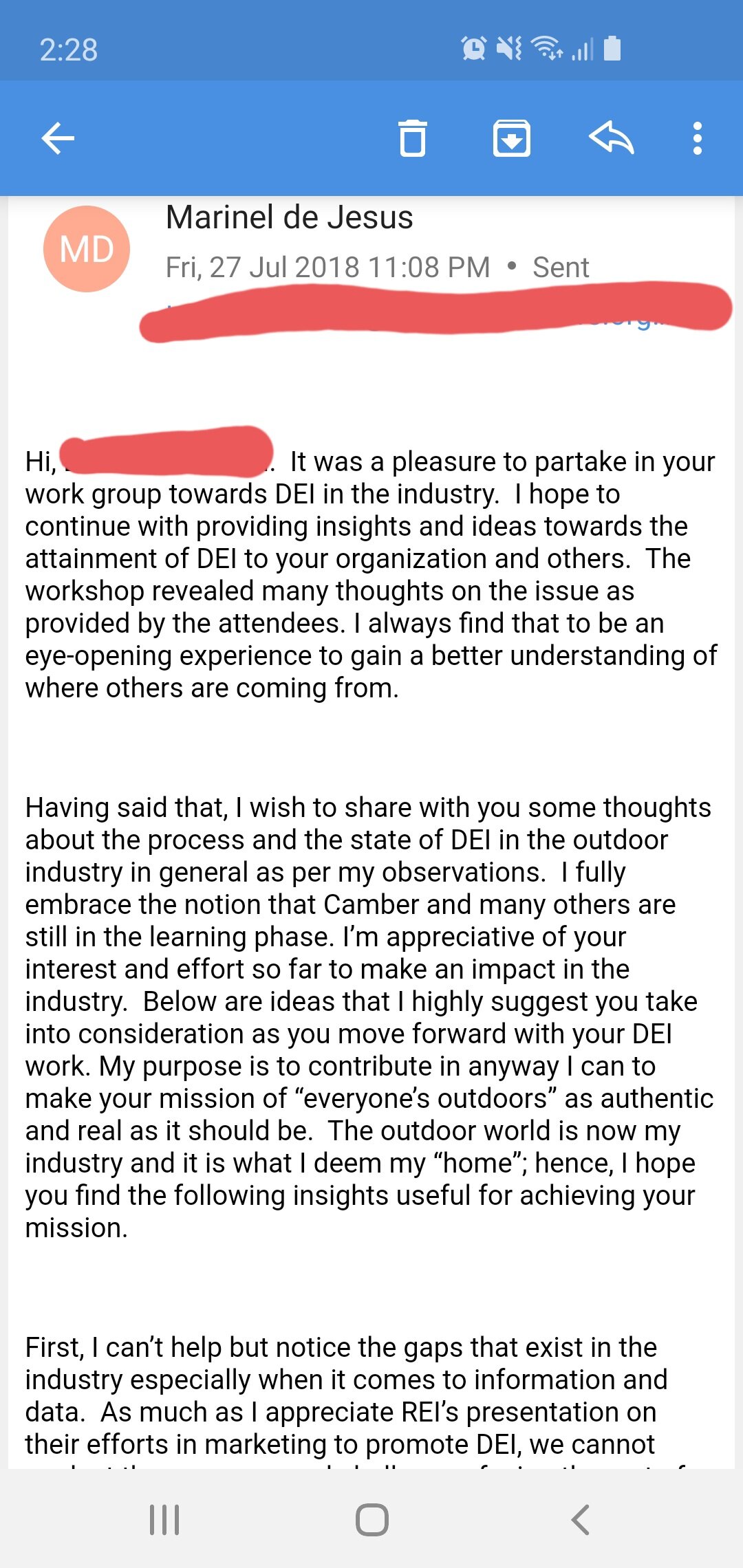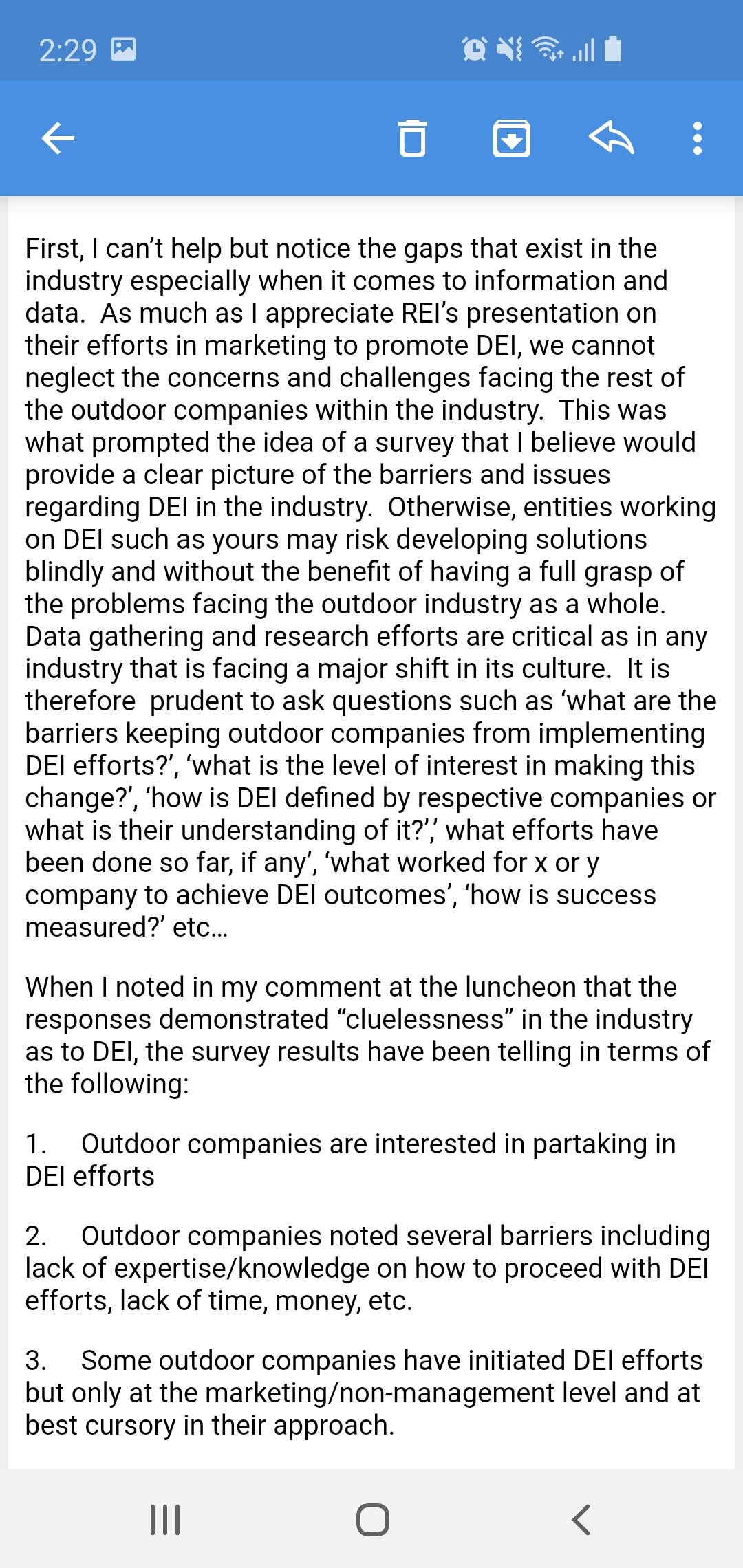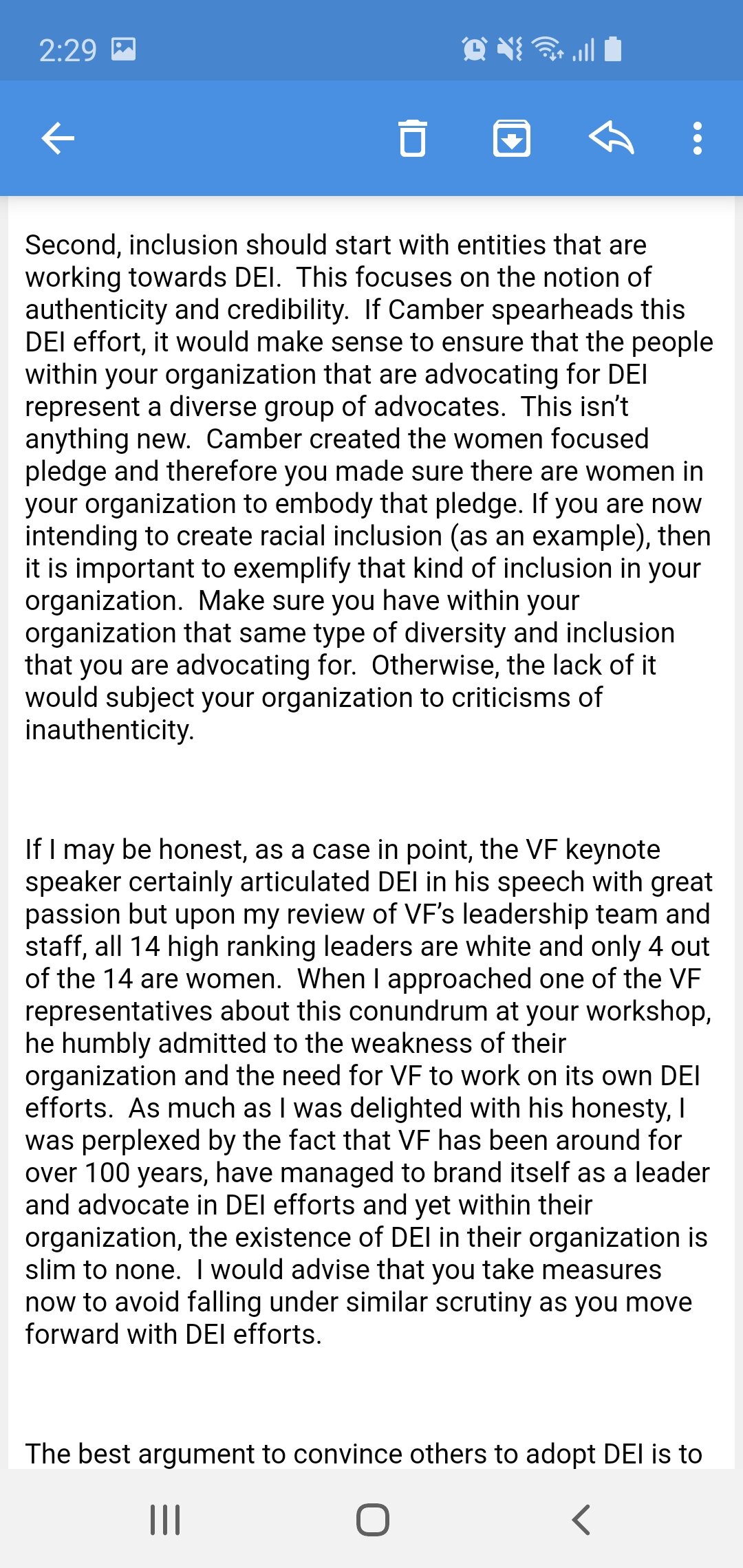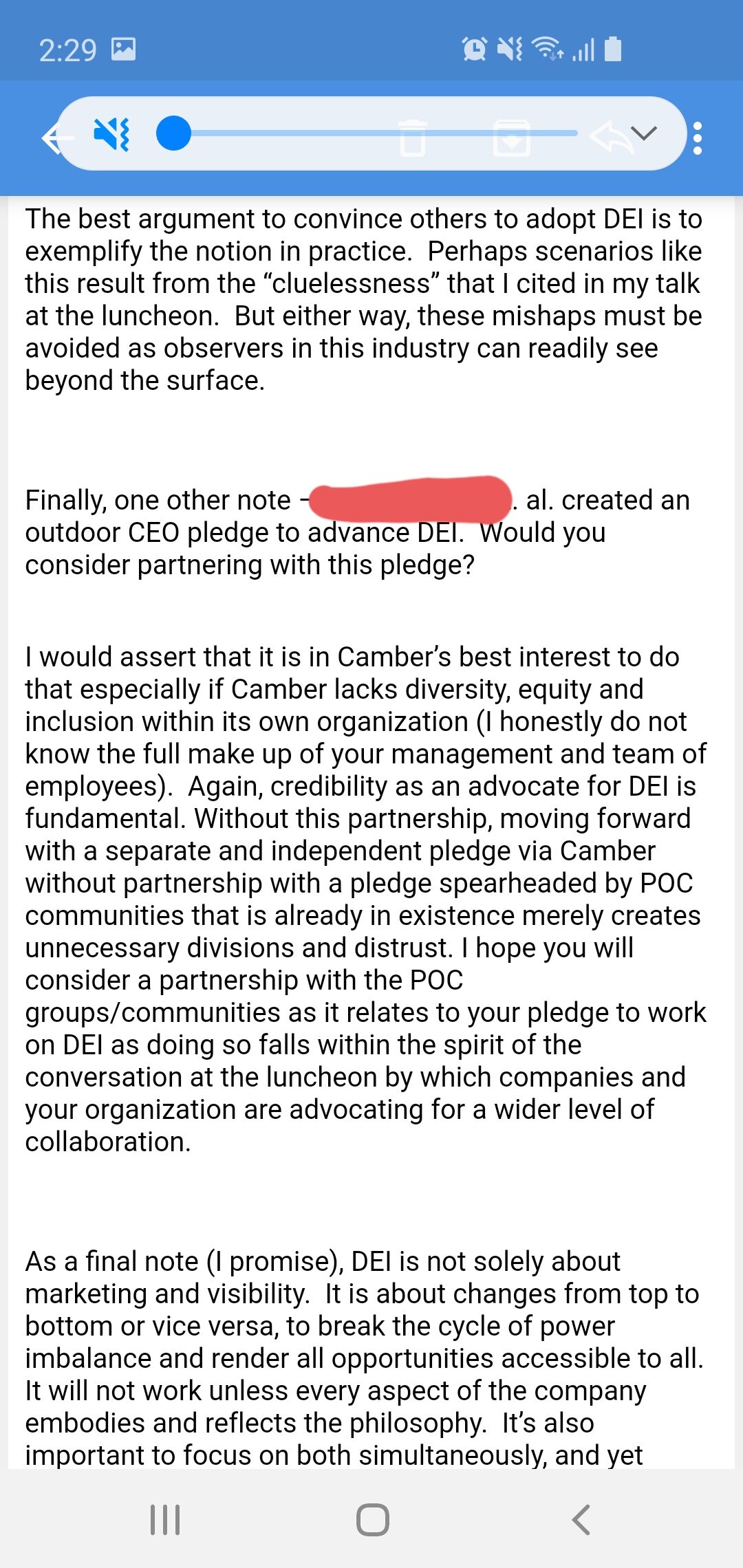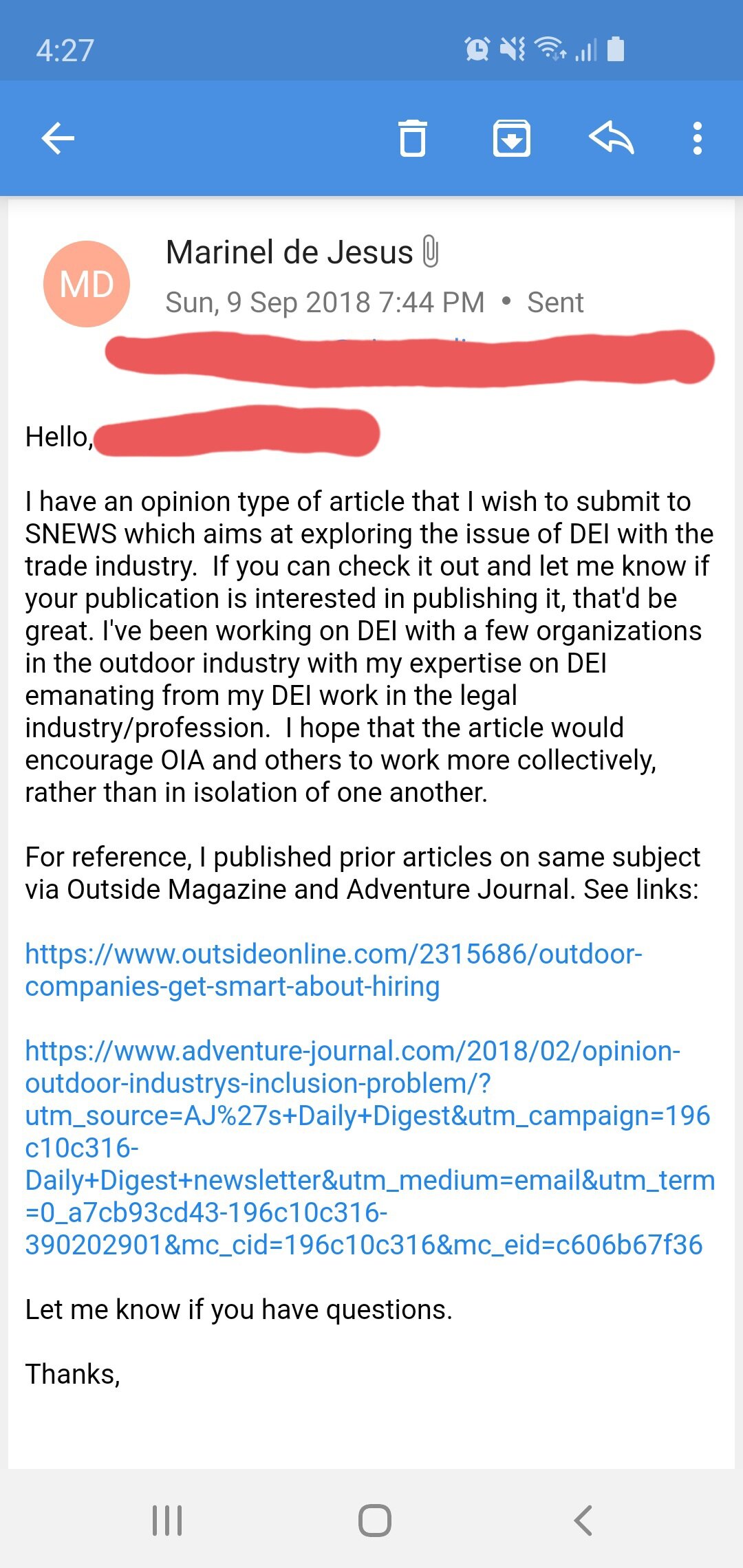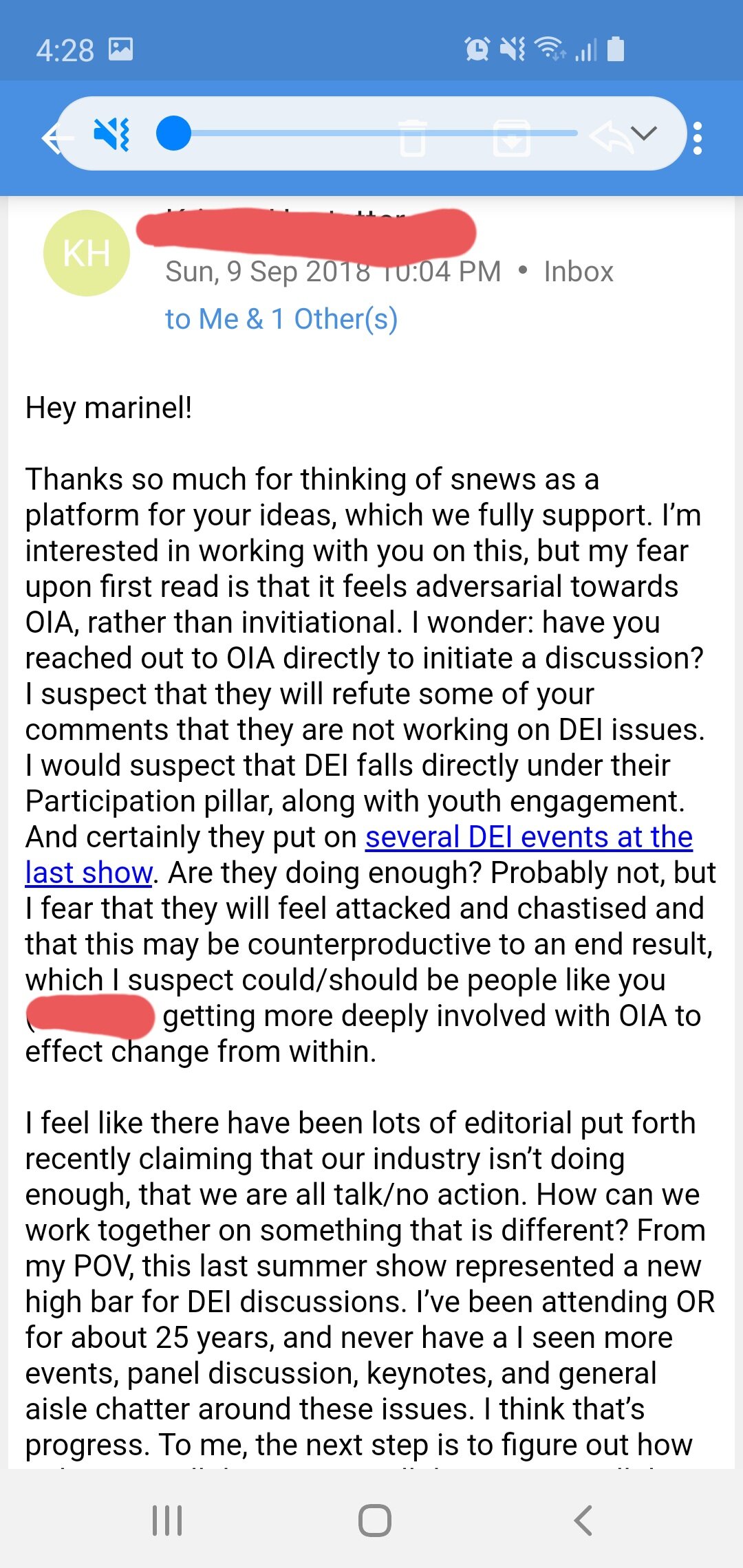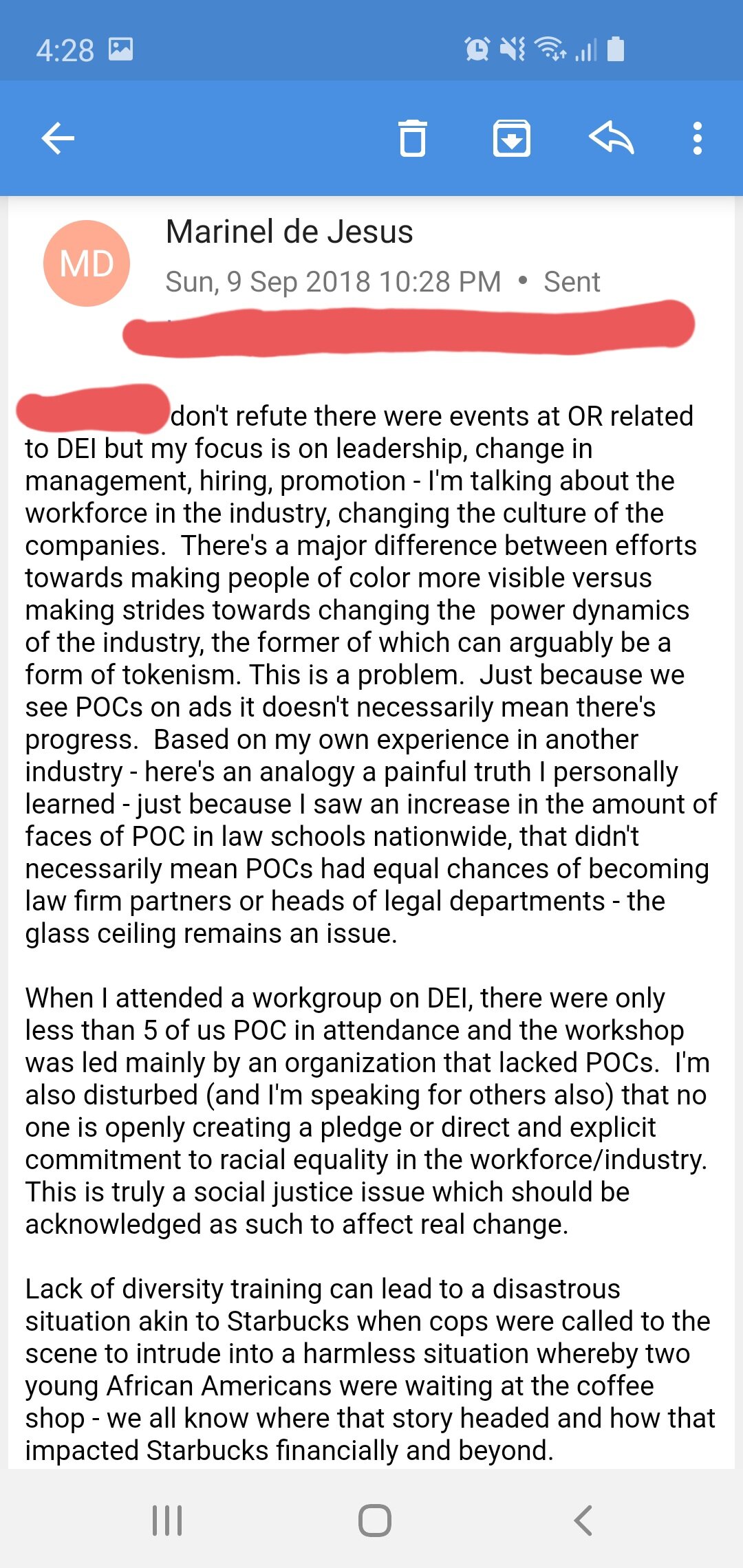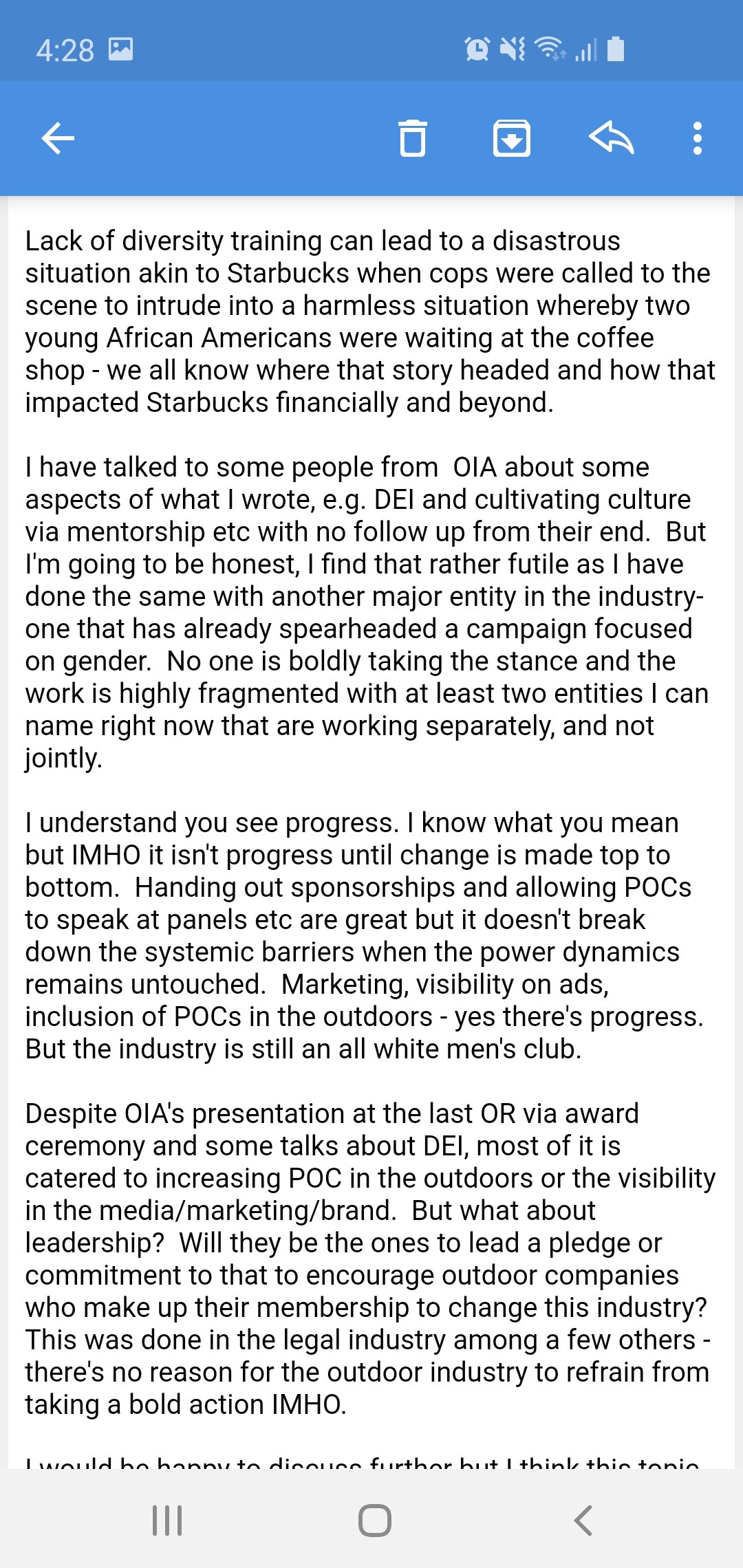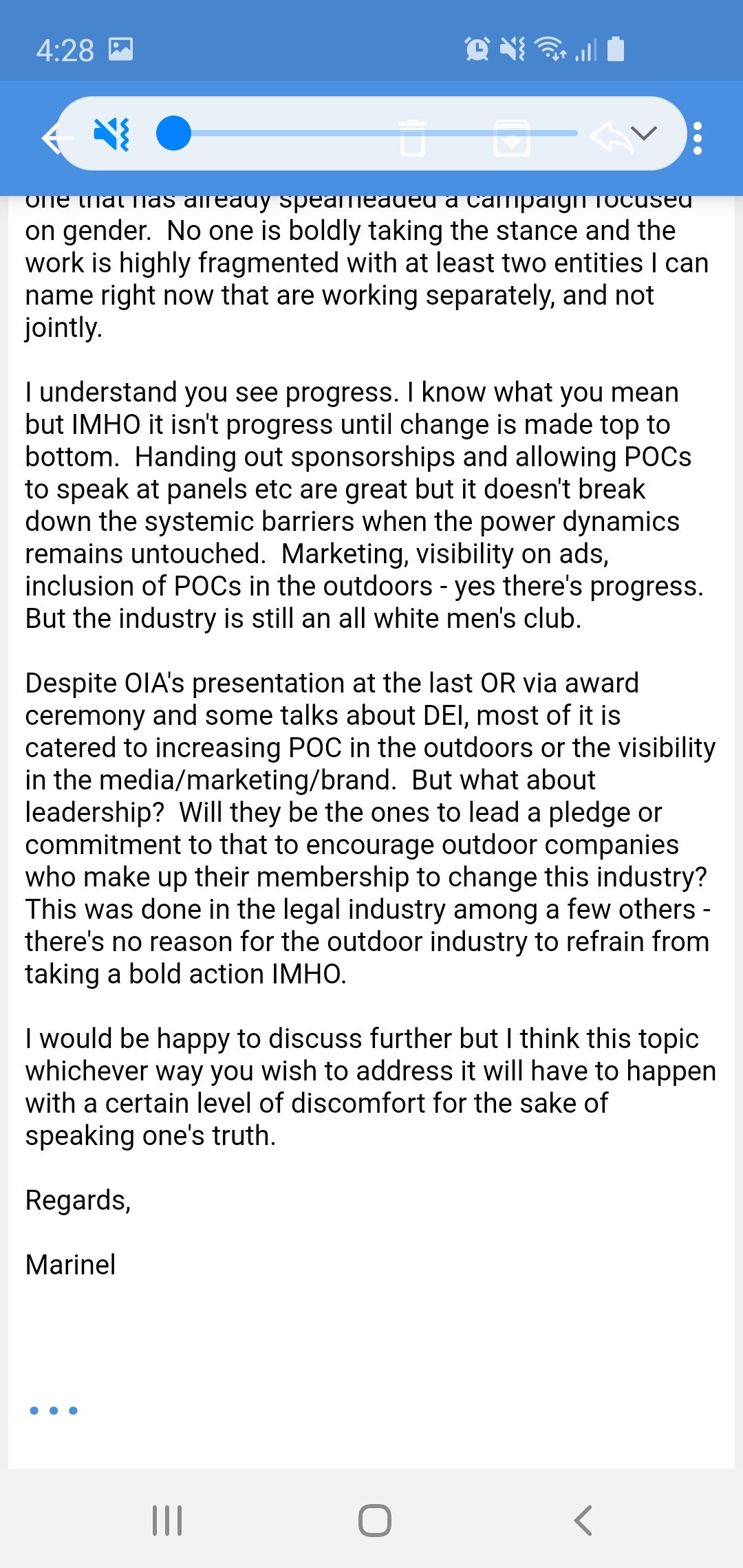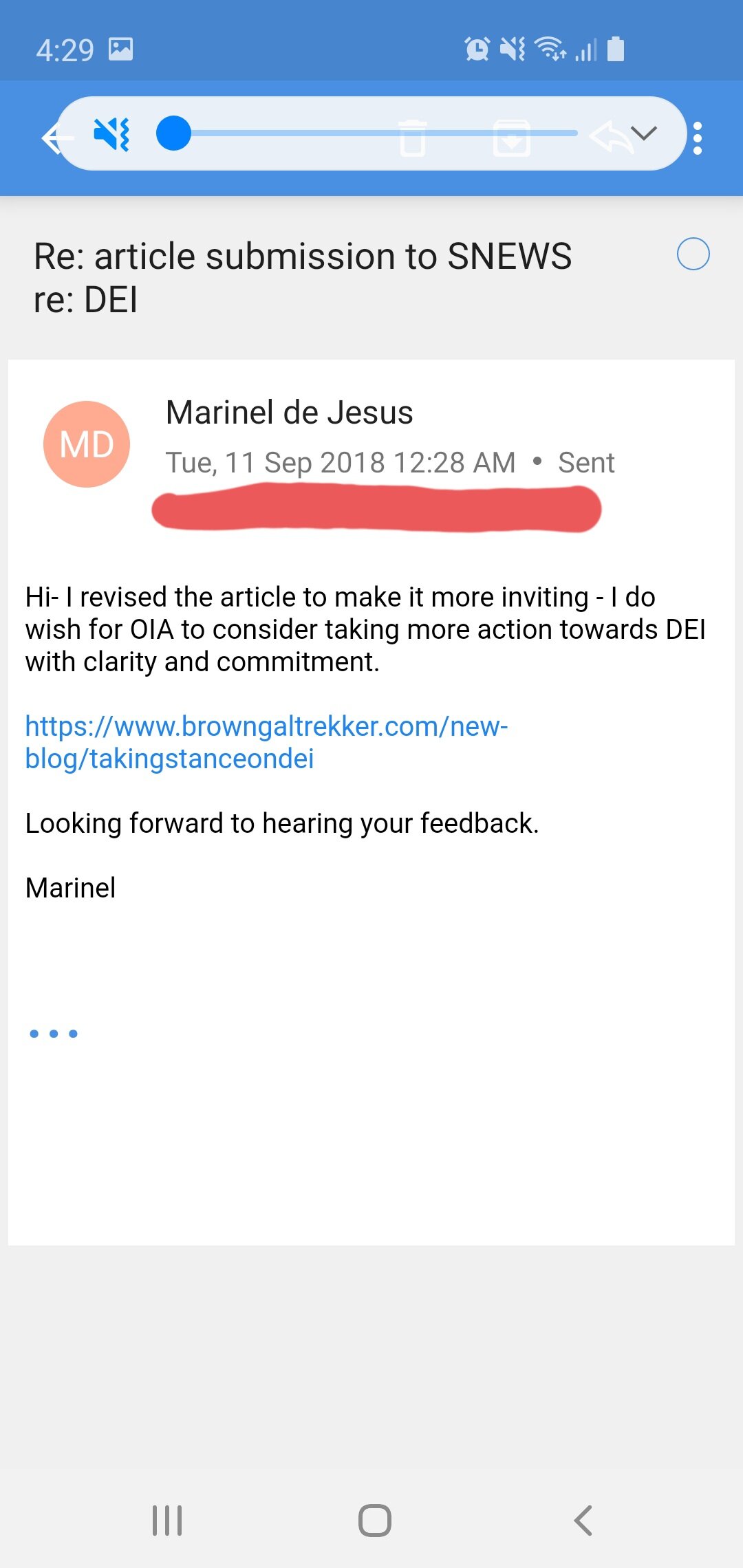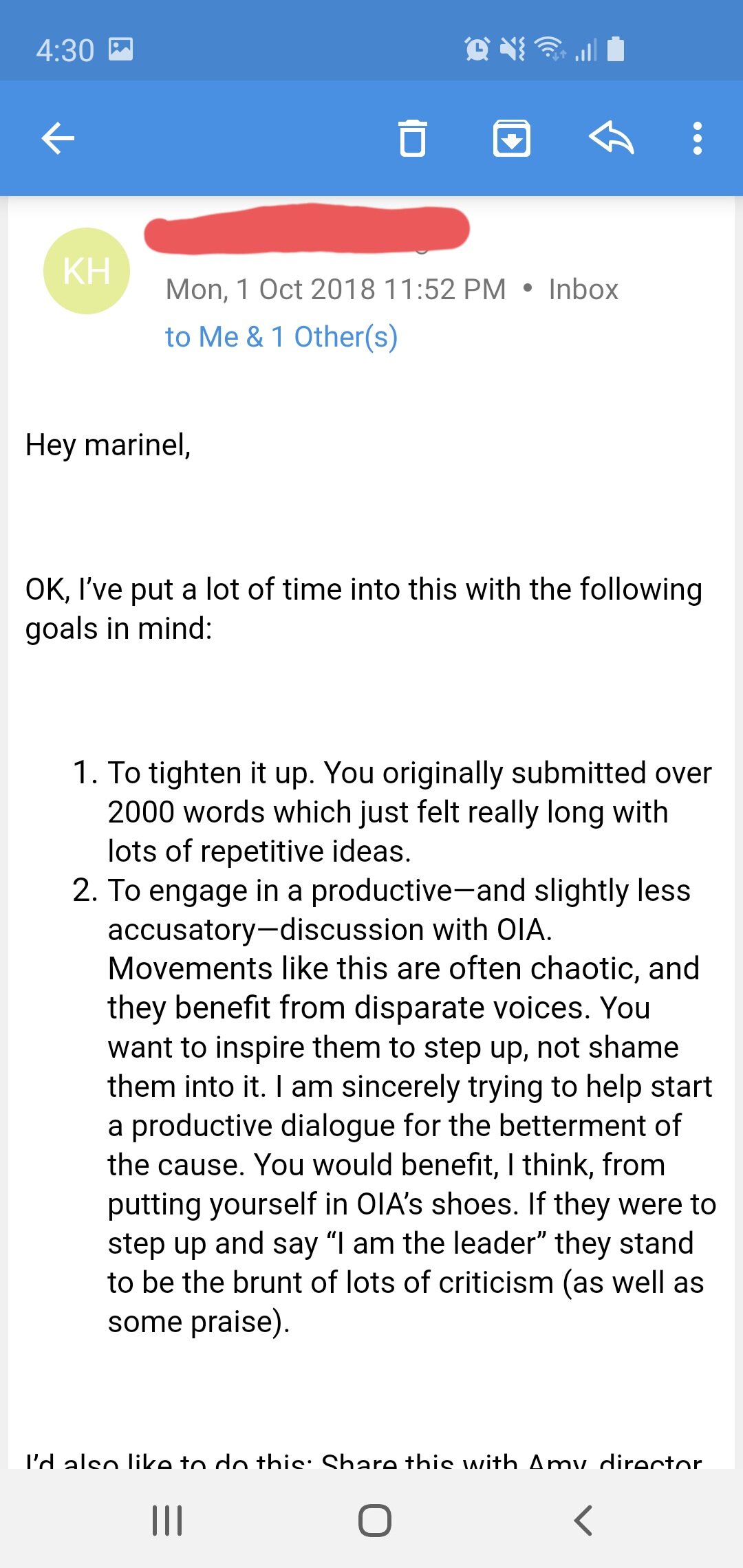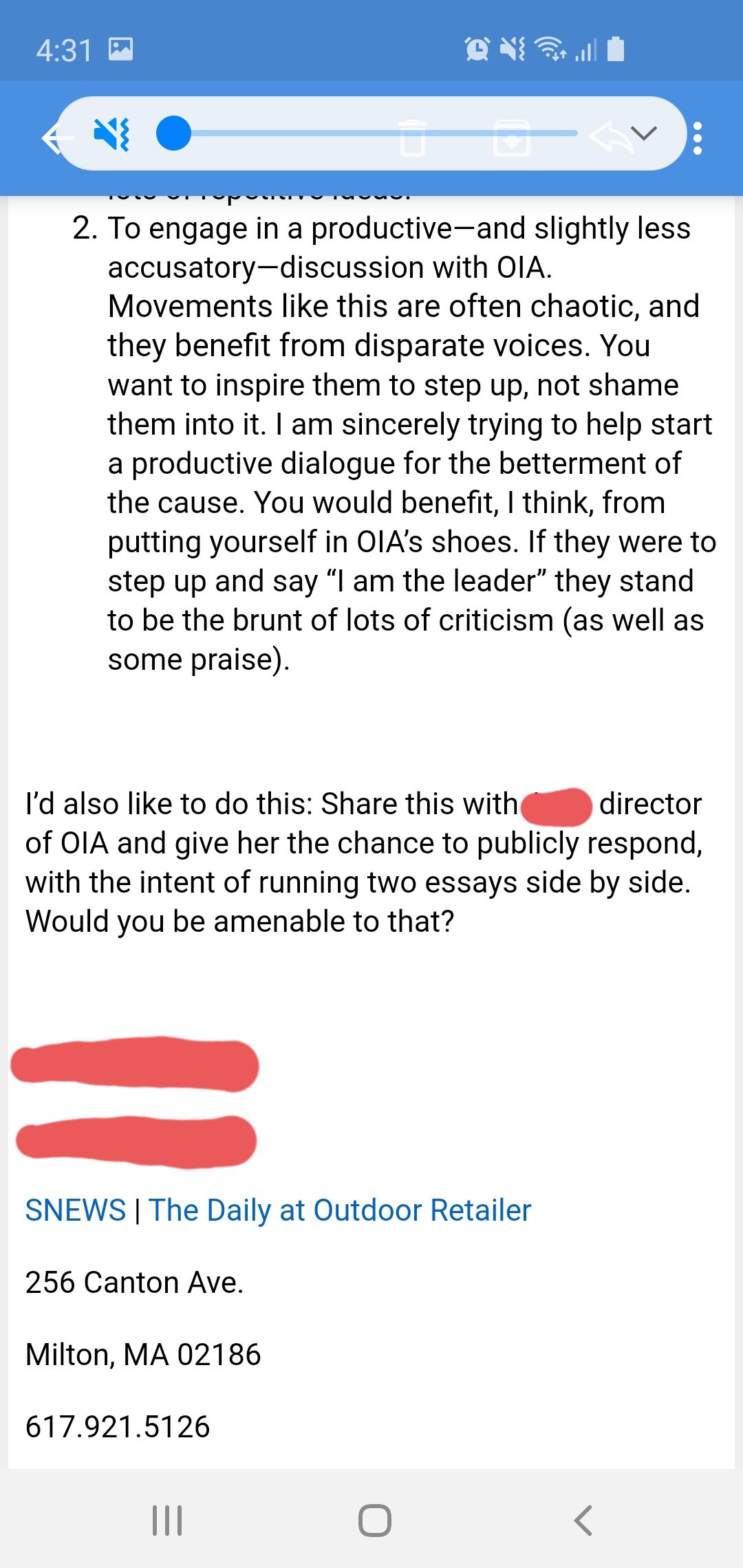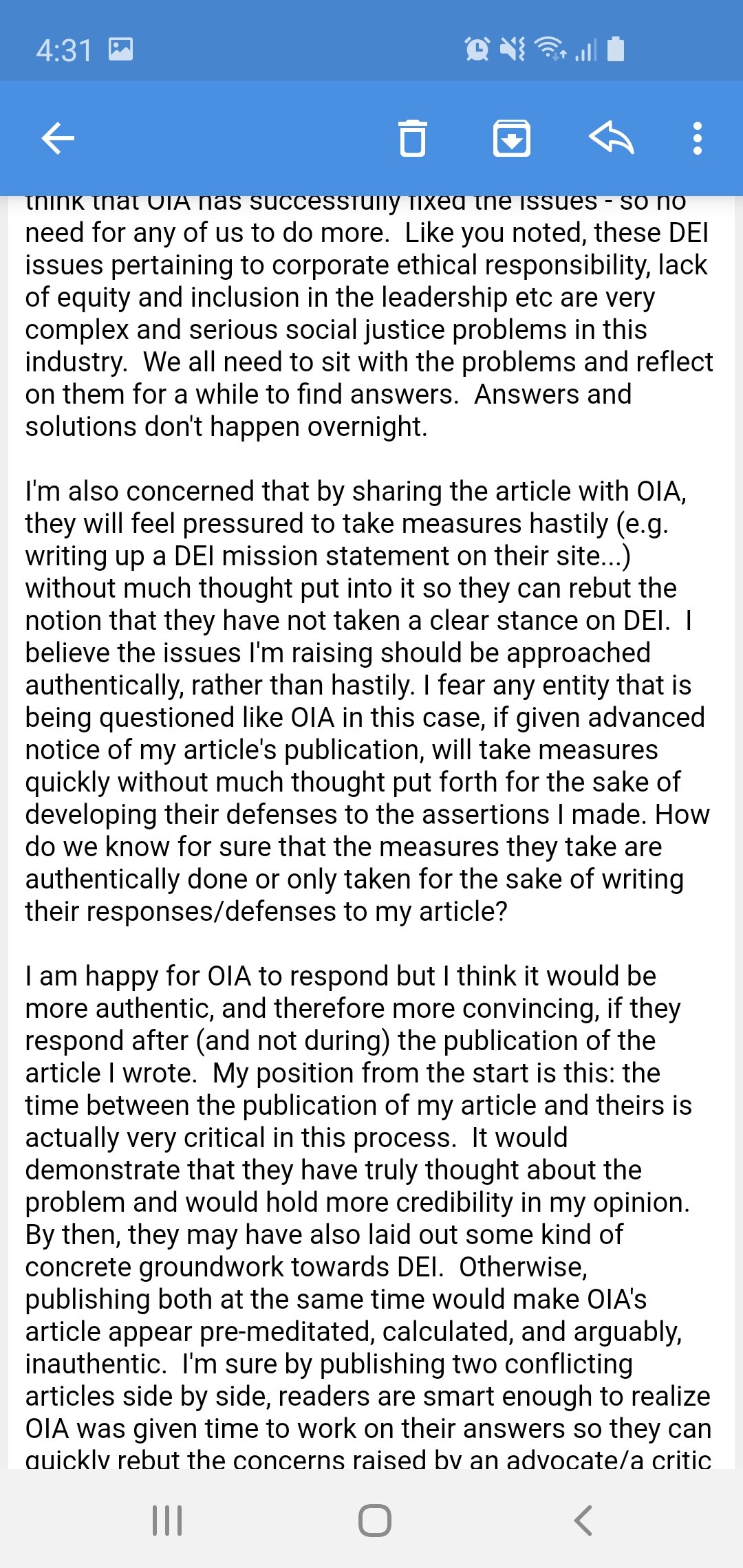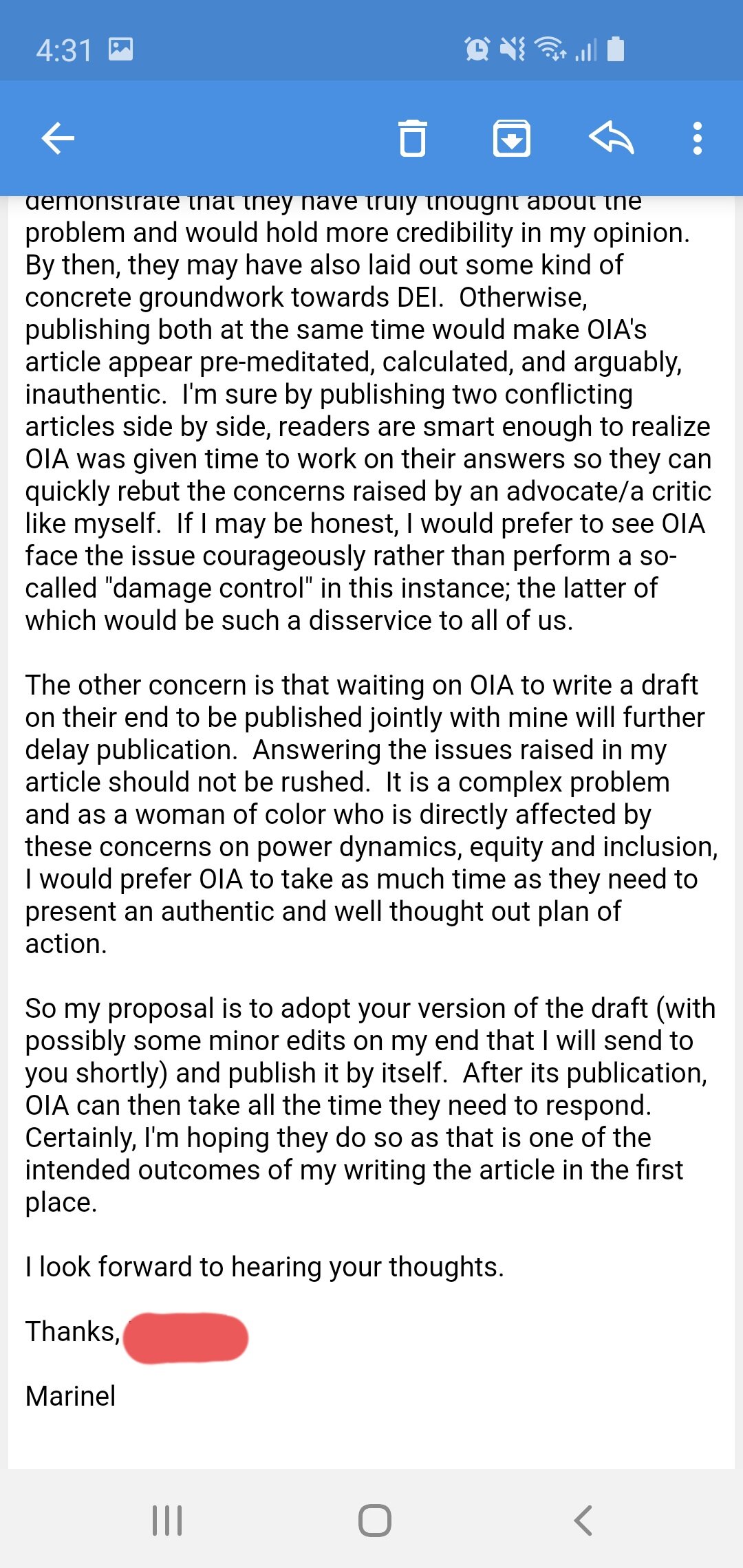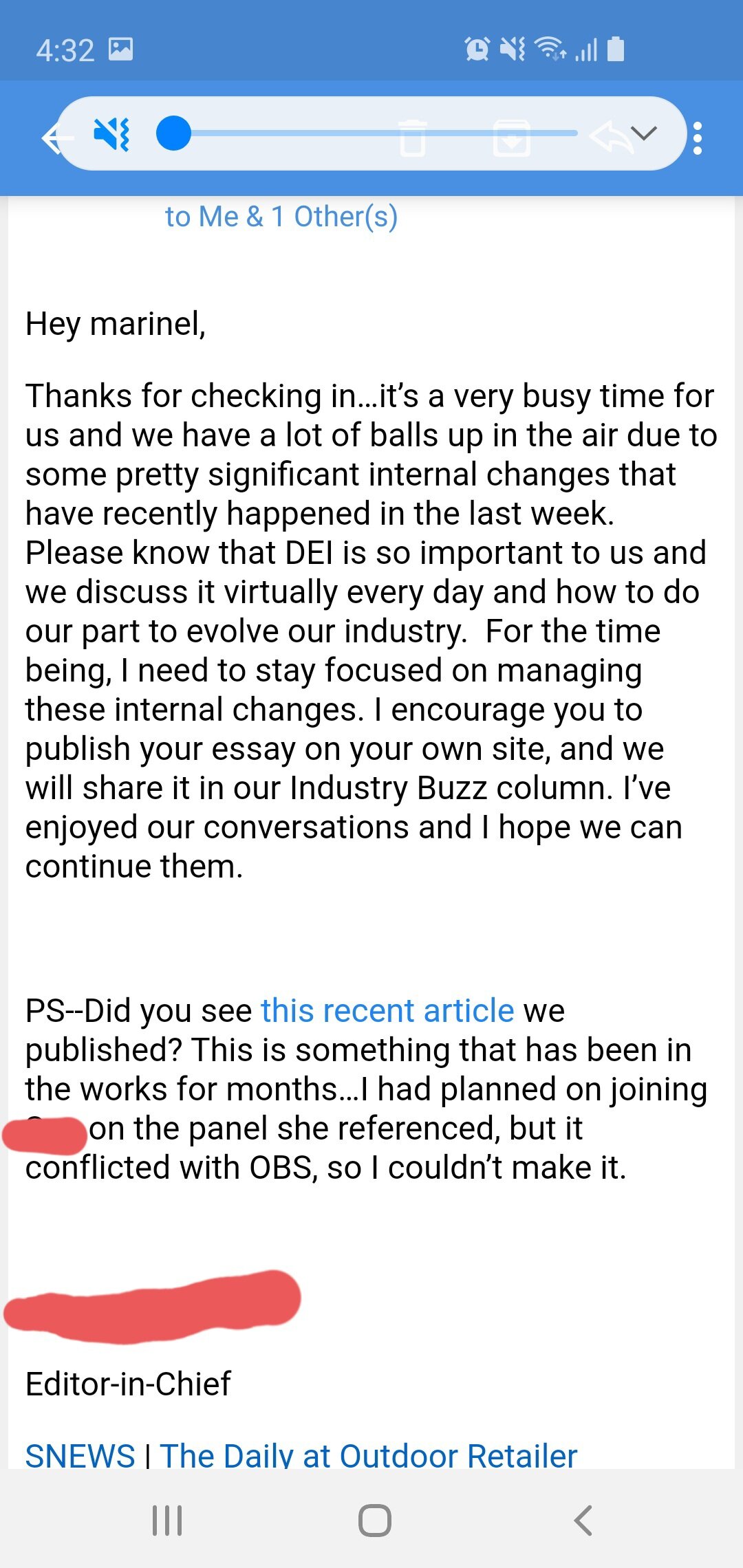SNEWS, OIA & Camber: A Case Study on the Outdoor Industry’s Systemic Racism, White Supremacy and Allyship (Part 1)
I wish to open the door to this discussion by stating the following:
The content that follows is based on first-hand observations emanating from my experiences in dismantling the systemic racism that is widespread within the outdoor industry. They include facts and opinions as a result of my investigation of the industry’s DEI efforts. I started my involvement in the outdoor industry in early 2018. Since then, the DEI efforts have notably assumed more relevance in the outdoors and its industry. The conversation that has ensued in the past two years, along with the pitfalls and mistakes committed by individuals and entities when it came to DEI efforts, demonstrates progress, no doubt, albeit relatively minimal. The assertions that follow are not intended to undermine said progress; rather, they are meant to create a starting point by which anyone who is a part of and/or invested in the outdoor industry can reflect independently on his/her own role in creating systemic changes that will take us closer to normalizing DEI, rather than maintaining DEI as the exception to the rule.
My entry into the world of the outdoor industry started vis a vis my first attendance at the Outdoor Retailer Show in January of 2018. Shifting from a 15 year career as a civil rights lawyer to becoming an entrepreneur and a writer in the outdoor and travel industries was a decision I made in 2017. From the start, the lack of diversity in the outdoors and its industry was evident. I expressed in detail my first impressions and all personal observations in support thereof via an article that I published entitled, When Money Is the Bottom Line: The Inclusion Problem in the Outdoor Industry.
Camber’s DEI Task Force & their DEI Fiasco:
Soon after the publication of the above article, the Executive Director of Camber Outdoors, a prominent entity in the outdoor industry that advocates primarily on behalf of women and for gender equality reached out to me directly to engage in a more detailed conversation about my observations of the industry. This ED was friendly and polite in her approach and asked pertinent questions on how to create DEI within the industry. Even though the ED failed to share with me concrete DEI steps that had been taken by her organization; and neither did she outline a list of concrete measures to be taken in the future, I was assured that a DEI task force involving some of the major stakeholders in the industry was already underway. Soon after that, I was invited to partake in said task force along with other BIPOC who were presumably invited to the table.
The task force commenced its work at the June 2018 OR show. VF Corporation, a company that owns North Face and other major brands, was assigned to facilitate the 3-4 hour discussion on DEI. During that very first in-person workshop, it became obvious that the attendees were mostly white individuals who represent various outdoor companies including REI. The decision to have VF Corporation to take the lead on this workshop was problematic from the start. VF was tasked to educate the group about DEI but their record with DEI within their own organization was far from impressive as the leadership team consisted of white people. This appeared to be the case despite their claim of many years of facilitating DEI workshops. The contradiction was unsettling.
It wasn’t the first time I was involved in a DEI task force or meeting. In my experience with DEI decades ago, topics that involve race, gender, and all social issues pertaining to marginalized groups have always warranted a much longer duration of in-depth discussions. However, in this instance, Camber decided that a mere half day of a discussion on social justice topics was sufficient. To me, this decision exacerbated an already questionable start. And, it only became worse over time as I began to notice how the manner in which the meeting was being facilitated was meant to cater to the sensitivities and well-being of the white individuals in the room. It became evident that the participants –the white people- steered clear of the words racism, race, white supremacy and more. As a result, I experienced a disturbing and contrived discussion of a topic that usually requires unwanted emotional labor on my end as a woman of color. No one dared to deviate from safe buzz words such as diversity, equity and inclusion. It was for sure one of the safest and most comfortable discussions for white people that I have ever witnessed in the DEI world, so much so, that my own comfort and well-being were compromised in favor of the well-being of my white counterparts.
When I raised concerns about this, the conversations fell into silence. The “white” comfort that was once there dissipated. To add insult to injury, speaking up as one of the very few women of color in the room also meant playing the role of a token. By being the recipient of the microaggressions and subtle racists attitudes of the white people in that room, it started to dawn on me that I was invited merely out of courtesy and as a dubious attempt at creating inclusion. I wasn’t there to create partnership with these white folks because the DEI conversation was quickly turning into a whitewashed version of it. I have experienced this kind of maneuvering by white people before. Such tactics have the egregious impact on the BIPOC community as it ensures that outspoken POCs like myself are forced to find her place within this white dominated space as prescribed by the white people in control of the system. It was either I conform or I face alienation by the group. In such instances, the goal is for someone like me to learn to conform with a white-centric and tone deaf version of DEI efforts and deem such endeavor as “allyship.” In so doing, the system of racism can remain intact and anything that remotely resembles a DEI effort will not in any way disturb the power dynamics within the industry; thereby perpetuating more of the same racist operations and behaviors that continue to this day in this white dominated industry.
Accordingly, this Camber DEI task force wasn’t meant to dismantle the systemic racism and white supremacy that permeated the inner workings of this industry; rather, it was meant to cater to the status quo of white supremacy and racist infrastructures. To do so ensures that those who have benefited economically from such paradigm remain in power at the expense of people like me. Such DEI efforts, whether conducted intentionally or not, create a huge negative impact on the BIPOC community. This was a classic way of appropriating the struggles of marginalized people in the hopes of silencing the adversaries of white supremacy that persists at the institutional level. The added benefit is the rise of a false sense of allyship, one that will one day reveal itself to be pro-oppressor when push comes to shove.
Without a doubt, it was one of the most uncomfortable experiences I ever had at the OR show. I explicitly expressed my concerns with the Camber ED via an email that I wrote following the June 2018 in person workshop. As always, the ED responded with the same level of politeness and civility but without imparting any sense of full understanding of the damage that the workshop had inflicted on its POC participants and the alienation of BIPOC advocates in the DEI space. The online version of the task force emulated the same problems, and as one of the only 4 to 5 women of color actively participating in this very white space, the experience was toxic.
In Janary of 2019, Camber hosted yet again another in person workshop for its task force members. In between the summer and winter workshops, I continued to be vocal about the lack of BIPOC leadership in this task force; but such demands were unheard. At the January 2019 workshop, VF was there like before to lead the workshop, and still then their leadership team was devoid of BIPOC representation. The same level of discomfort ensued for the very small number of POCs in the room. Evidently, the BIPOC representation was lacking at the event just like the first time. Camber also didn’t manage to forge any kind of partnership with the BIPOC-led Outdoor CEO pledge for whatever reason. In short, the same concerns I raised following the first workshop remained. The space was uncomfortable like the first time as the white members and the facilitators themselves were free to evade the same controversial words such as racism, race, white supremacy etc. I was literally in the same nightmare all over again.
Towards the end of this meeting, Camber announced the creation of a DEI pledge for outdoor companies – a pledge that was being led by Camber’s ED and her cohorts who were all white. This created a controversy as there was already an existing POC-led outdoor CEO pledge that was initiated a few months back. Despite my advising this Camber ED to create a partnership and/or to support the POC led DEI pledge, she instead decided to form her own DEI pledge, which revealed to the entire outdoor community her true intentions behind her superfluous DEI efforts. Later that day, as planned, Camber announced its white-led version of a DEI pledge; thereby creating a major fiasco that led to the demise and resignation of Camber’s ED. You can read more about this fiasco via this article: Part III: The Outdoor Industry, Colonized.
SNEWS & The Outdoor Industry Association (OIA): The (White Supremacy) Allyship
After the Camber fiasco, the fragmentation and the tension among DEI advocates rose to the surface. Camber’s DEI efforts, despite having the best intentions, set a poor example of allyship. This controversy, in fact, solidified the inherent systemic issues that have fueled the racism and culture of white supremacy within the industry. The Camber DEI task force that I was a part of was disbanded shortly thereafter. Camber issued an apology and a renewed commitment to DEI, citing an attempt for a more thorough evaluation of future DEI efforts. A POC Camber board member stepped in as acting ED. The BIPOC community was enraged and overtly expressed their sentiments on social media. Slowly, more white people were showing interest in the DEI issue – a topic that stayed in the sidelines at the OR show, on social media and elsewhere. But the traction in hindsight was not enough to affect systemic and long-term changes within the industry.
Out of frustration with a slew of self-proclaimed DEI allies, I reached out to SNEWS to submit an opinion piece that I wrote, which focused on the status of DEI within the industry and a direct appeal to the leadership team of OIA to act and lead its member companies towards systemic changes. The op-ed was entitled, Will OIA Take a Stance? The Inclusion Problem in the Outdoor Industry, Part II. I submitted the piece to the editor of SNEWS who agreed to review and publish the article after a round of edits on her end despite sharing her concern about the criticisms of OIA that may arise from the publication of my opinion on their media site. However, after completing the edits, I started to receive more pressure from the editor to share my opinion piece with OIA and to speak with OIA ‘s Executive Director before moving forward with the publication on their website. She also reiterated several times her desire to give OIA the opportunity and time to write their response to my letter and for my opinion piece and OIA’s response to be published at the same time.
In the past, I have written op-ed articles that were published as stand-alone pieces. I never had an editor suggest that I provide a copy of my opinion to the subject of my writing prior to the article’s publication. Doing so minimizes and compromises the intended impact of an op-ed on its readers. I was totally uncomfortable with the editor’s suggestion, which I expressed directly with her in writing.
This suggestion triggered a level of suspicion as I had observed first-hand the close and intricately woven relationship between OIA and SNEWS. These dealings were evident during the OR shows but also from the type of articles that SNEWS publishes on their website. SNEWS prides itself as the outdoor industry’s primary media outlet on the latest trends and news in the industry. It maintains regular contact with the industry’s major stakeholders, many of whom make up SNEWS’ audience and are white. In addition, SNEWS’ efforts towards DEI are dubious at best as most, if not all, of its DEI articles are written, yet again, in a manner that are safe and comfortable for the outlet’s white audience. In my opinion, SNEWS’ style in approaching DEI is calculated and often times work to benefit the white audience more than it does the BIPOC community. The published work by BIPOC writers on their platform are carefully selected to ensure that no controversy ensues with OIA or any major outdoor entities for that matter. And, should some controversy arise, SNEWS has proven to me how much of an expert it is in distancing itself from the controversy.
When outdoor publications steer away from controversies, I believe such approach is indicative of an inauthentic stance on DEI. This approach warrants questioning. SNEWS wants to play it safe with everyone which serves them well but it hurts the BIPOC DEI advocates in the long run because SNEWS is choosing not to take anti-racist measures. SNEWS has demonstrated a tendency to move away from unfiltered truths and much needed blunt conversations about racism for the sake of protecting its own interests. I understand that position completely and I would have preferred the editor to be transparent about this. Instead, my conversations with her misled me to think that SNEWS was a genuine DEI ally. Unfortunately, the outcome of this so-called collaboration with SNEWS yielded a performative effort on their end. From the start, I was candid about my position on the editor’s suggested approach towards the handling of my op-ed piece. In response to the editor’s suggestions, I made it clear in writing my disagreement with publishing my opinion piece side by side with OIA’s response letter. To me, that was a subtle way to diffuse my arguments and minimize any negative criticisms that my op-ed might inflict upon OIA and its supporters.
A few days later, acting on the sole idea of SNEWS’ editor, the ED of OIA reached out to me to schedule a meeting. I found myself yet again feeling forced to engage in a conversation with a major entity in the industry where I was being persuaded to conform with OIA’s notion of DEI effort and provide them with validation or support at the expense of compromising my truths as a POC. The phone meeting with OIA’s ED was reminiscent of the same conversations I had with the ED of Camber – same tone, same promises, same ambiguous manner of discussing DEI issues devoid of substance and solid, concrete plans to create DEI. In fact, the conversation was much more uncomfortable this time as OIA’s ED repeatedly imposed upon me the notion that Camber was assigned to deal exclusively with DEI issues; thereby, dismissing my urging of the ED and OIA to act.
However, there was a problem with OIA’s assertion. At the time of our phone meeting, Camber’s DEI task force was disbanded and in the process it lost the trust and credibility needed to affect change. Camber also primarily serves women as it is widely known as an entity that advocates for gender equality. As such, Camber arguably lacks the capacity to run an effective and meaningful DEI effort that tackles race, a contention that became a reality when the above-noted fiasco happened. With that in mind, I urged OIA to take on the role of leading and forging partnerships with BIPOC DEI advocates, or at the very least, issuing a DEI statement on their website and hiring an independent organization to oversee DEI work in the industry, both of which were rejected by the OIA ED.
OIA was clearly dismissive of their role to lead or act on the DEI issues – with which, ironically, many of its member companies were at that time struggling to address. Making matters worse, the phone conversation with her also involved a third person – a POC – to bear witness to the exchange of words between us. Despite his constant validation of the viewpoints I made in the op-ed and during the actual phone conversation, it was clearly implied via his statements that his stance was compromised by being an employee of OIA. I gathered from his statements and tone that he really didn’t have a choice but to validate and defend the ED’s position during our phone call. Suffice it to say, I felt yet again that the conversation we just had was conducted for the purpose of “damage control.” It was meant to serve the best interests of OIA and its predominantly white leadership team. Again, this exemplified the fallacy of allyship from white leaders, and to a lesser extent, from POCs who are in leadership positions. All such actions combined only results in the retention of racism and white supremacy within prominent outdoor organizations such as OIA. It also demonstrated the complexities of being a POC in the DEI movement whereby a POC finds himself without a real choice except to protect his/her own self-interests by conforming with the priorities of white leaders at the organization where he/she is employed. This is a personal decision to be made at the expense of the BIPOC community.
SNEWS did not publish my opinion piece. Ultimately, the editor proffered an excuse for not publishing it. The excuse she gave fell in the realm of “being too busy” despite the fact that the edits to the article were done and not much else was left in order to get it published. She instructed me to publish it on my own media site, and by doing so, SNEWS could then merely link to my article. This was not my original intention. Clearly, SNEWS never had any real intention to take the bold step of publishing the piece the way they had done previously with other DEI articles for fear of offending OIA and its cohorts. After all, publishing what I wrote would arguably be seen as an endorsement from SNEWS of the contentions within the opinion piece, some of which were highly controversial as the editor herself deemed the truths asserted in my op-ed as a form of “shaming.”
Of course, truth can hurt especially when the subject of it is not ready to face it. This shaming allegation that the editor made was misguided at best. At worse, it felt like another tactic to silence my voice. I believe there is a need to learn to differentiate between substantiated, well thought out opinions and those that are clearly not. In my view, the publication of my op-ed was simply not something that this editor was willing to pursue, especially when the article called out for OIA to step up. The compromise that suited SNEWS came at a price in the form of silencing my voice and minimizing the strength of my article by acting in contrary to the actions one expects from a real ally. The editor’s shaming allegation and other above noted suggestions from her were all done to manipulate my reality so I acquiesce to her suggestion that I publish my opinion on my website instead and have SNEWS include a link on their weekly news round-up. This maneuver reduced my voice as a DEI POC advocate to the same puny level of a mere side note.
This encounter with SNEWS’ editor was revealing of SNEWS’s real stance on DEI. Oftentimes, outdoor industry companies and entities act and speak ambiguously about their so-called allyship with DEI. In contrast, SNEWS’ actions made it clear how they viewed my type of voice on this social justice issue – my voice is the kind that they deem as contrary to their own agenda. It needed to be suppressed. The editor’s ultimate decision also demonstrates that SNEWS would rather choose to be complicit with the industry’s systemic racism than take the bold step of challenging the industry that they themselves are a part of by urging specific entities with the power and control to face accountability. As a result, only opinions and articles that they render harmless to their cohorts have a decent chance to be published on a major outdoor industry focused media entity like SNEWS. By doing so, SNEWS manages to take advantage of the hype that currently exists with DEI work. SNEWS portrays itself as a DEI ally when all they are truly doing is appropriating and exploiting the struggles of the BIPOC communities to elevate their brand. Any piece written by a BIPOC that deviates from a white conformist narrative or threatens the existing power dynamics will prompt SNEWS to take the necessary action to ensure utmost protection of the industry’s status quo – a systemically racist industry that continues to perpetuate a thriving culture of white supremacy.
The inner workings of Camber, OIA and SNEWS are all interconnected. As these three organizations hold their respective individual influence and power, they are able to control the systems in place to make it work to their benefit primarily, even if such decisions come at a high price for the BIPOC communities that they claim to care about and serve. My interactions with these three organizations were with high level white female leaders of each organization who had the capacity to make decisions to alleviate racism in the outdoor industry. And yet -
None of them acted against racism.
None of them were willing to listen and act on my input which emanated directly from my lived experiences as a woman of color.
None of them allowed BIPOC to lead the way.
None of them made instrumental changes to themselves and the industry.
None of them even know that it is they who are the real barriers to the systemic racism and white supremacy.
I waited for this genuine notion of allyship that never came and unlikely to ever will. These outdoor industry leaders who happen to be all women chose to maintain a status quo that caters to white supremacy culture, whether overtly or covertly, by any means necessary. As a result, the DEI efforts from their end were self-serving, white conforming, and a means to pacify, control and silence the angry voices of the BIPOC communities. Therefore, when these three entities decide to work together as a collective, or better yet, as a system, the amount of power they hold can continue to enforce and perpetuate the inherent white dominance and racism in this industry. This truly begs a slew of difficult questions for many of us BIPOC - ones that we have lived with all our lives:
When and how can we ever end systemic racism?
How much power do we really have to end this?
And, how much are we willing to sacrifice for this?
And for the white people who hold the power and privilege,
Why are you still pretending?
Are you really willing to act and be anti-racist?
We see you. All of it.
Writer’s Note: The above narrative of my experiences with the outdoor industry serves as one of the many examples of the fallacy of “allyship” with white people whose loyalty can easily lean towards the retention of the status quo. As BIPOC, we need to reject this performative allyship in its entirety. The racism in this industry is first and foremost a human rights and a social justice issue. Anything short of that approach is unconscionable. There are many more experiences that mirror the above examples out there that have yet to be told. These stories are how Blacks, Indigenous and People of Color experience systemic racism and white supremacy first-hand. Lean into them, listen and learn.
This is part one of a series of writings on this topic. Future parts will address the following (1) A critique of the DEI efforts at the June 2019 OR Show (2) The Black Lives Matter Movement and Its Impact on the Outdoor Industry in 2020 (3) A shift from DEI to JEDI with a focus on accountability and transparency (3) Where do we go from here to dismantle white supremacy and systemic racism?
*Last updated on June 24, 2020.
